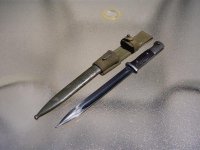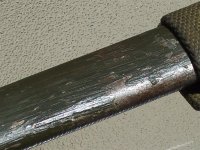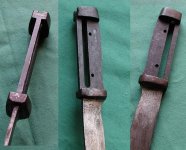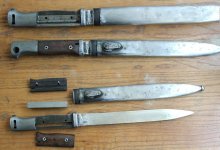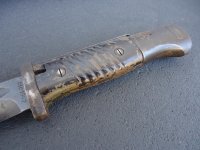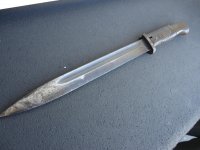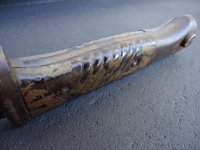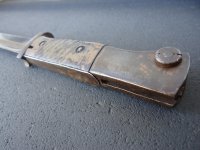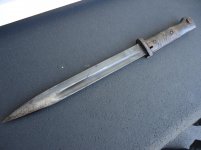
You are using an out of date browser. It may not display this or other websites correctly.
You should upgrade or use an alternative browser.
You should upgrade or use an alternative browser.
Green bayonets
- Thread starter grimlin13
- Start date
denny gaither
Moderator - RIP
Very interesting. I don't recall having ever seen one with painted grips. Maybe its the lighting, but the shade of green looks kinda funky. Thanks for posting...
Here is a matching 42asw that looks like it was painted using a broom for a brush.


Here is a matching 42asw that looks like it was painted using a broom for a brush.
Attachments
BerlinerLuebecker
Senior Member
Has anyone ever studied serial patterns re: painting? I've seen black paint on early scabbards a number of times, but does anyone know when/why this practice was used (and by whom)?
grimlin13
Senior Member
It isn`t the lighting and I agree that the color looks kind of funky. It isn`t the same shade of green as on your bayonet. I`ve seen a bayonet with a greyish-blue painted scabbard and another with a white scabbard,both of which had "smooth" paint applied like the black ones. grimlin13Very interesting. I don't recall having ever seen one with painted grips. Maybe its the lighting, but the shade of green looks kinda funky. Thanks for posting...
Here is a matching 42asw that looks like it was painted using a broom for a brush.


Last edited:
AndyB
Senior Member
The bayonet has a great frog, early 1934 dated? the bayonet itself has a new green paint, the 42cvl is nice as complete matching, but the sharpening and no finish decrease the value, as seen on pommel and blade no finish there,it should be blued. In case of Denny piece, it could be the paint was added as protection of damaged blueing on scabbard, that sometimes happened, but is not typical. It could be done postwar too.
grimlin13
Senior Member
I have found another bayonet that is green. I have also found an SA dagger that has it`s scabbard painted green and a knife that has it`s sheath painted green. Now this is what my thought is on these items being painted green.The Hermann Goering Division`s flag was green,same green shade as the green on these items(or close to it). Could the bayonets,SA dagger, and knife be linked to that division? Just a thought.
Attachments
-
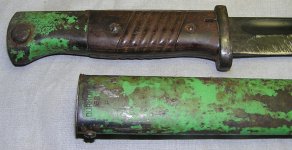 green 1938 Durkop.jpg279 KB · Views: 16
green 1938 Durkop.jpg279 KB · Views: 16 -
 green 1938 Durkopp.jpg188.8 KB · Views: 14
green 1938 Durkopp.jpg188.8 KB · Views: 14 -
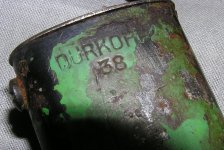 green 1938 Durkopp 3.jpg224.4 KB · Views: 17
green 1938 Durkopp 3.jpg224.4 KB · Views: 17 -
 green 1938 Durkopp 4.jpg260.8 KB · Views: 15
green 1938 Durkopp 4.jpg260.8 KB · Views: 15 -
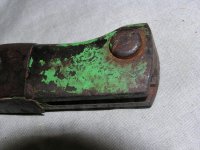 green 1938 Durkopp 5.jpg303.9 KB · Views: 17
green 1938 Durkopp 5.jpg303.9 KB · Views: 17 -
 Danzig 1915 2.jpg150.5 KB · Views: 14
Danzig 1915 2.jpg150.5 KB · Views: 14 -
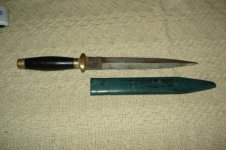 Danzig 1915 3.jpg203.1 KB · Views: 13
Danzig 1915 3.jpg203.1 KB · Views: 13 -
 Danzig 1915.jpg166.1 KB · Views: 11
Danzig 1915.jpg166.1 KB · Views: 11 -
 SA Dagger green scabbard.jpg82.3 KB · Views: 17
SA Dagger green scabbard.jpg82.3 KB · Views: 17 -
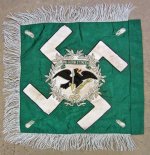 Goring Division standard.jpg216.2 KB · Views: 17
Goring Division standard.jpg216.2 KB · Views: 17 -
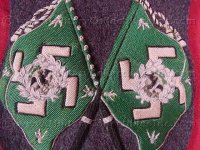 Goring Division Standard Bearers Patch.jpg88.1 KB · Views: 11
Goring Division Standard Bearers Patch.jpg88.1 KB · Views: 11
Last edited:
AndyB
Senior Member
Hello , the piece as mentioned by Yours is too sharpened, so certainly upgraded postwar, under the grren paint is visible on scabbard it was cleaned with sandpaper, which is certainly not proper,so it must be declared as some postwar painting job, same as the knife is most probably a fantasy or a fake. The SA daggers are painted too, but about this i dont have any information. Many IR had the green color not only Goering Regiment or higher units.
On Your piece are removed finish and blueing is only in fullers and You mentioned a sharpening which was not real in german service.So it should be sayed a painted piece. Note the pommel has no origin finish.
On Your piece are removed finish and blueing is only in fullers and You mentioned a sharpening which was not real in german service.So it should be sayed a painted piece. Note the pommel has no origin finish.
grimlin13
Senior Member
Okay, so there were other German divisions or units that had green flags or green on their flags,like the Jagerbattallion Finnland,or the 1st LAH Division 11/1, or the Luftwaffe Jager-Regiment and I believe that there was a Pionier battalion or company that used a greenflag. There were several Ordnungspolizei and Schutzpolizei flags that were green. I know all of this and guess I should of included them in my thoughts on this and not just alluded to the H.G. Division.
I am not arguing with you on what you say AndyB. but, are you saying that of all the German battle bayonets made during the Third Reich era, none of them were sharpened to be used for fighting? That all sharpening was done post war? I find that hard to believe. Am I also to believe that if a bayonet or scabbard has any finish except blueing or phosphate, it was also done post war? Didn`t the German Military Bands have white scabbards on their bayonets? Have all bayonets that have paint on their scabbards been painted post war? There must be some liittle guy some where,alive or dead, that is getting a good laugh about the bayonet scabbards he painted green, or white, or black, or blue-grey.
I am not arguing with you on what you say AndyB. but, are you saying that of all the German battle bayonets made during the Third Reich era, none of them were sharpened to be used for fighting? That all sharpening was done post war? I find that hard to believe. Am I also to believe that if a bayonet or scabbard has any finish except blueing or phosphate, it was also done post war? Didn`t the German Military Bands have white scabbards on their bayonets? Have all bayonets that have paint on their scabbards been painted post war? There must be some liittle guy some where,alive or dead, that is getting a good laugh about the bayonet scabbards he painted green, or white, or black, or blue-grey.
AndyB
Senior Member
I am not arguing with you on what you say AndyB. but, are you saying that of all the German battle bayonets made during the Third Reich era, none of them were sharpened to be used for fighting? That all sharpening was done post war? I find that hard to believe. Am I also to believe that if a bayonet or scabbard has any finish except blueing or phosphate, it was also done post war? Didn`t the German Military Bands have white scabbards on their bayonets? Have all bayonets that have paint on their scabbards been painted post war? There must be some liittle guy some where,alive or dead, that is getting a good laugh about the bayonet scabbards he painted green, or white, or black, or blue-grey.
SO about the sharpening of bayonets S84/98 is more discussion in german forum, there are in 1944 and 45 some directions of Wehrmacht manuals about punishing the sharpening of blades, the bayonet was a equipment that should be good stored and preserved by a soldier, who have it writen in his soldbuch and must be returned in correct condition, so when not it must be payed. There are exact amounts about this.
So we speak about normal duty, and soldiers owned bayonet, the bayonet could be sharpened by a capturing soldier to sample a GI or soviet, or partisans, same as in front condition a spare bayonets could be used in this way. For cutting there were enough IM42 and other combat knives same as soldiers have their own utility knives, i dont know about using a 6mm and 250mm blade for cutting meat or some small food?
About painting, i dont mentioned a winter camo,AK tan, KM black paints or similar by little damage made field repairs, but the majority of them have a proper finish under the paint, or similar to Denny piece are correct in all other ways. Your color is for me not proper for a combat using.Same as Your piece was certainly without origin blueing and sharpened when it was painted.
I live in country where the front was in 1944 and there are many S84/98 made in last 60 years to farmer knives for rough work in field as it was for free. How do You can determine when it was changed? when the serving of 44asw was 1 year and the remaining 68 years it was used as utility knife. There is no remains of finish. But in collection as we have a dbase exist 95% of pieces correct and not sharpened. best regards,Andy
PS added 3 pieces, one was used for normal cutting, the grips were removed by me, but the pommel was cutted off, second piece is a butcher killing knife from Gebr.Heller 37, the wood was woried out and was full of meat rest when i found it, the last one a S241G matching with correct grips but missing press stud polished metall with blade used as letter opener.
Attachments
Last edited:
gew8805
Well-known member
I have to agree with AndyB, the occasional painting of bayonet scabbards did happen in both World Wars, but only as a way of freshening the appearance of a scabbard for appearance sake, otherwise they were left alone until they could be replaced and the damaged/worn item returned for proper rework. They were certainly not painted the color of the unit's flag.
As far as sharpening; due to the fact that the majority of people know absolutely nothing about how to sharpen a knife or any other blade, the process can lead to serious damage and is usually discouraged by military organizations of all nations. During the First World War, bayonets were allowed to be sharpened on mobilization for war, but it had to be done properly, almost always by the unit's trained armorer and if you look at Imperial bayonets, those that show sharpening are almost always properly done with a minimum of metal removal. What was done in the 1933 - 1945 era, I have no idea but if done, it was done properly. The individual soldier was discouraged from doing the work himself and his equipment was inspected while on issue, not just at the time of discharge. If damaged, the soldier received punishment.
As far as sharpening; due to the fact that the majority of people know absolutely nothing about how to sharpen a knife or any other blade, the process can lead to serious damage and is usually discouraged by military organizations of all nations. During the First World War, bayonets were allowed to be sharpened on mobilization for war, but it had to be done properly, almost always by the unit's trained armorer and if you look at Imperial bayonets, those that show sharpening are almost always properly done with a minimum of metal removal. What was done in the 1933 - 1945 era, I have no idea but if done, it was done properly. The individual soldier was discouraged from doing the work himself and his equipment was inspected while on issue, not just at the time of discharge. If damaged, the soldier received punishment.
grimlin13
Senior Member
Hello
This is a true yellow camouflaged.
Bonjour
Voilà une vrai camouflée jaune.
View attachment 58364View attachment 58365View attachment 58366View attachment 58367View attachment 58368View attachment 58363View attachment 58362
Thank you for your post. Interesting paint and finish under the paint.



